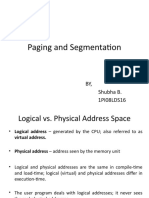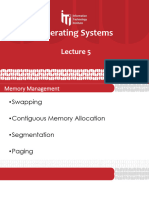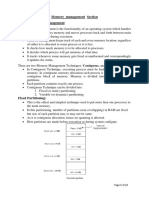Paging: Logical Address Is A Pair: (Page Number P, Page Offset D)
Paging: Logical Address Is A Pair: (Page Number P, Page Offset D)
Uploaded by
Nishant BhattCopyright:
Available Formats
Paging: Logical Address Is A Pair: (Page Number P, Page Offset D)
Paging: Logical Address Is A Pair: (Page Number P, Page Offset D)
Uploaded by
Nishant BhattOriginal Title
Copyright
Available Formats
Share this document
Did you find this document useful?
Is this content inappropriate?
Copyright:
Available Formats
Paging: Logical Address Is A Pair: (Page Number P, Page Offset D)
Paging: Logical Address Is A Pair: (Page Number P, Page Offset D)
Uploaded by
Nishant BhattCopyright:
Available Formats
Paging
permits the physical address space of a process to be noncontiguous whole process in main memory, but does not have to be contiguous split physical memory into fixed-sized blocks called frames split logical memory into blocks of same size called pages last page of process may not occupy an entire frame (i.e., some internal fragmentation) frame and page size are an efficiency issue; page size is between 512 bytes and 16 MB depending on the computer architecture paging increases context switch time, but overhead of page table decreases as page size increases logical address is a pair: (page number p, page offset d) which indexes into page table (which resides in the PCB). page table contains the base address of each frame in physical memory p must be in range of the pages d must be less than the page size physical address = frame_number * page_size + offset For instance, (2, 325). Does paging increase the context switch overhead? and if so, why? Overhead of page table decreases as the page size increases. Use registers if page table small (< 256 entries). However, on most contemporary computers page table might be very large (> 1 million entries). Keep it in main memory and have 1 register point to it, but that approach increases the context switch time. Solution: cache (translation look-aside-buffer or TLB) example: memory access = 100 ns cache search = 20 ns hit ratio = 80%
effective access time of hit = 120 ns effective access time of miss = 220 ns (0.8)(20+100) + (0.2)(20+100+100) = 0.8*120 + 0.2*220 = 96 + 44 = 140 ns 40% slowdown when compared to no paging. How does performance improve with a 98% hit ratio?
Page Table Structure
Structure of the page table
main idea: page the page table itself hierarchical paging (applicable in 64-bit systems?) hashed page tables inverted page tables o decreases amount of memory required to store page table, but o increases what? o what about shared memory?
Segmentation
paging separates (and even blurs) the user's view of memory from physical memory segmentation is a memory management scheme which supports the user view of memory compiler automatically constructs segments reflecting the input program loader assigns these segments segment numbers logical address is: (segment name/num, offset) segmentation table: an array of (seg base, seg limit) pairs (2,53) (4300+53) = 4353 eliminates internal fragmentation external fragmentation possible segmentation fault
Memory Management Techniques: a Summary
single contiguous overlays fixed (static) partitions relocation (dynamic) partitions paging segmentation paged segmentation demand paging segmentation with demand paging
Intel Pentium uses pure segmentation (or segmentation with paging).
Memory Management Summary
goal: high degree of multiprogramming (most efficient use of memory). why? with a fixed memory size, how can we increase the degree of multiprogramming? six main ways all under the umbrella of packing as many processes as possible into main memory o dynamic loading o dynamic linking o swapping o sharing code o compaction o virtual memory
memory management schemes range from simple single-user approaches to complex multiprogramming schemes such paged segmentation most important factor is the hardware? why? a simple base or base/limit register pair is sufficient for single and multiple partition schemes, but paging/segmentation require mapping tables as the memory management scheme becomes more complex, the time required to translate from a logical to physical address increases; page table o registers o TLB o main memory
to maximize memory use, we must reduce memory waste or fragmentation o fixed-size partitions (and paging to a small extent) suffer from internal fragmentation o variable-sized partitions and segmentation suffer from external fragmentation OS must also provide protection so that processes do not access data outside of their region in memory swapping: now part of the ready queue can exist in second memory; allows more processes to run than can be fit into main memory
You might also like
- 28 Point Checklist Commissioning Med DevDocument6 pages28 Point Checklist Commissioning Med DevNur Aqilah IsmailNo ratings yet
- Developing A Research ScheduleDocument2 pagesDeveloping A Research ScheduleSyab AdisyaNo ratings yet
- Combined Paging and SegmentationDocument33 pagesCombined Paging and SegmentationTech_MX100% (1)
- Memory Management: Operating Systems Lecture NotesDocument38 pagesMemory Management: Operating Systems Lecture NotesdnlkabaNo ratings yet
- Memory ManagementDocument37 pagesMemory ManagementlakshayNo ratings yet
- Memory Management: Main MemoryDocument8 pagesMemory Management: Main Memorycutezee782No ratings yet
- Multi-Level Page Tables & Paging+ Segmentation CombinedDocument8 pagesMulti-Level Page Tables & Paging+ Segmentation CombinedMegha BatraNo ratings yet
- Paging & Segmentation: Frédéric HazizaDocument21 pagesPaging & Segmentation: Frédéric HazizaKriti TanwarNo ratings yet
- Memory Management: Background Swapping Contiguous Allocation Paging Segmentation Segmentation With PagingDocument55 pagesMemory Management: Background Swapping Contiguous Allocation Paging Segmentation Segmentation With PagingsumipriyaaNo ratings yet
- Notes m4Document26 pagesNotes m4divyashiv7974No ratings yet
- Unit 3.2 Address Spaces, PagingDocument44 pagesUnit 3.2 Address Spaces, PagingPiyush PatilNo ratings yet
- Unit 5memory ManagementDocument61 pagesUnit 5memory Managementharshkumarbalaji117No ratings yet
- Memory Management1Document58 pagesMemory Management1Manoj YadavNo ratings yet
- Paging and SegmentationDocument27 pagesPaging and SegmentationRajesh Leo100% (1)
- Segmentation and Paging: SolutionsDocument6 pagesSegmentation and Paging: SolutionsNguyễn Phan Đăng KhoaNo ratings yet
- Virtual Memory: Course COMP6153 Effective Period: September 2017Document33 pagesVirtual Memory: Course COMP6153 Effective Period: September 2017Pravda CaliburNo ratings yet
- Os Unit IiiDocument50 pagesOs Unit IiiSaitamaNo ratings yet
- PagingDocument76 pagesPagingAnonymous RuslwNZZlNo ratings yet
- UNIT-2 OSDocument31 pagesUNIT-2 OSSuryadev Singh RathoreNo ratings yet
- CH 08Document8 pagesCH 08kapil_arpitaNo ratings yet
- Paging and Segmentation: BY, Shubha B. 1PI08LDS16Document27 pagesPaging and Segmentation: BY, Shubha B. 1PI08LDS16Rajesh LeoNo ratings yet
- PagingDocument45 pagesPagingManalAmerNo ratings yet
- Virtual MemoryDocument19 pagesVirtual Memoryah chongNo ratings yet
- Chapter 7 Virtual Memory Part-1Document33 pagesChapter 7 Virtual Memory Part-1Ahmed Ibrahim GhnnamNo ratings yet
- Memory Management (Platform Technologies)Document43 pagesMemory Management (Platform Technologies)Luigi SeriñaNo ratings yet
- Unit-3 (OS)Document36 pagesUnit-3 (OS)ammujastyNo ratings yet
- Group 7Document42 pagesGroup 7Waleed Abdullah2k19 EE603No ratings yet
- Unit-3 (OS)Document36 pagesUnit-3 (OS)rishi reddyNo ratings yet
- Chariya Assignment 5Document12 pagesChariya Assignment 5ravindu_rathnayakaNo ratings yet
- Unit 3Document87 pagesUnit 3devileela921No ratings yet
- Updated-4th unit--OSDocument47 pagesUpdated-4th unit--OSwitob23385No ratings yet
- Unit 5memory ManagementDocument59 pagesUnit 5memory Managementtamannayadav741No ratings yet
- 05MemoryManagement 2012Document76 pages05MemoryManagement 2012Kusum ShruthiNo ratings yet
- Paging in OSDocument6 pagesPaging in OSPranjalNo ratings yet
- OS_Question&Answers_M4 & M5Document22 pagesOS_Question&Answers_M4 & M5muttagisiddappa4No ratings yet
- Chapter 7 Virtual Memory p1Document33 pagesChapter 7 Virtual Memory p1ahmedibrahimghnnam012No ratings yet
- Unit 5Document47 pagesUnit 5gdzqxjgomvnldysggkNo ratings yet
- Memory Management: Background Swapping Contiguous AllocationDocument51 pagesMemory Management: Background Swapping Contiguous AllocationFazrul RosliNo ratings yet
- Tutorial 7 SolutionDocument8 pagesTutorial 7 Solution21803013No ratings yet
- OriginalDocument5 pagesOriginalT VinassaurNo ratings yet
- T3 - Memory Management-Virtual MemoryDocument32 pagesT3 - Memory Management-Virtual Memorylordzjason14No ratings yet
- Memory SummaryDocument2 pagesMemory SummaryvsbbwnNo ratings yet
- Virtual MemoryDocument18 pagesVirtual MemoryAaditya UppalNo ratings yet
- OS - Lect 5Document43 pagesOS - Lect 5aehab1912No ratings yet
- Module 4Document43 pagesModule 4FazalNo ratings yet
- Memory ManagementDocument12 pagesMemory Managementa49028316No ratings yet
- Memory ManagementDocument22 pagesMemory ManagementkristinamelquerymarcojosNo ratings yet
- Lecture-28MemoryManagement2Document24 pagesLecture-28MemoryManagement2ME22B1042 THUMATI VINEELA KUMARINo ratings yet
- Operating Sytems: B.Tech Ii Yr (Term 08-09) Unit 4 PPT Slides Text BooksDocument53 pagesOperating Sytems: B.Tech Ii Yr (Term 08-09) Unit 4 PPT Slides Text BooksRamakumar MVNo ratings yet
- Memory-Management StrategiesDocument70 pagesMemory-Management StrategiesNico Jhon R AlmarinezNo ratings yet
- Explain Paging and Segmentation in DetailDocument4 pagesExplain Paging and Segmentation in Detailimranahmedkhan42No ratings yet
- Lecture 10aDocument49 pagesLecture 10aRui E n SimNo ratings yet
- mmDocument9 pagesmmtrinetrabanerjee.aiml2021No ratings yet
- Week 10 OsDocument2 pagesWeek 10 Osaniketmandre7No ratings yet
- Virtual MemoryDocument29 pagesVirtual MemoryTRANAND TRNo ratings yet
- CS604Document36 pagesCS604chiNo ratings yet
- OS Unit 5-MemoryDocument60 pagesOS Unit 5-Memorydeathstar3jediNo ratings yet
- SegmentationDocument35 pagesSegmentationmanishbhardwaj8131No ratings yet
- Operating Systems (CS/CPE 408) : Memory ManagementDocument8 pagesOperating Systems (CS/CPE 408) : Memory ManagementMCSEANDCCNANo ratings yet
- SAS Programming Guidelines Interview Questions You'll Most Likely Be AskedFrom EverandSAS Programming Guidelines Interview Questions You'll Most Likely Be AskedNo ratings yet
- Build Your Own Distributed Compilation Cluster - A Practical WalkthroughFrom EverandBuild Your Own Distributed Compilation Cluster - A Practical WalkthroughNo ratings yet
- Vmware Horizon Subscription: Feature ComparisonDocument3 pagesVmware Horizon Subscription: Feature Comparisongege gegeNo ratings yet
- Requirement Gathering and Analysis Design Implementation or Coding Testing Deployment MaintenanceDocument3 pagesRequirement Gathering and Analysis Design Implementation or Coding Testing Deployment MaintenanceJoseph NgatungaNo ratings yet
- Girl From NowhereDocument326 pagesGirl From NowhereSayani DasNo ratings yet
- Marv CV OfficialDocument3 pagesMarv CV OfficialMarv Ordoña LumayagNo ratings yet
- Value Stream Mapping2Document4 pagesValue Stream Mapping2Ahmed M. HashimNo ratings yet
- 1 - Spend Visibility - Hands-On Script - PartnerIntProd - 2016Document37 pages1 - Spend Visibility - Hands-On Script - PartnerIntProd - 2016Rodolfo ChungNo ratings yet
- Cybercrime Processing Bag and Tag ProdedureDocument68 pagesCybercrime Processing Bag and Tag ProdedureHerman ClederaNo ratings yet
- Tosvert Vf-A7/P7 Serial Communication Function ManualDocument66 pagesTosvert Vf-A7/P7 Serial Communication Function ManualMr.K chNo ratings yet
- ElectricalDocument27 pagesElectricalmadhusudhan reddyNo ratings yet
- STE Micro Project Report PDFDocument21 pagesSTE Micro Project Report PDFShivam †No ratings yet
- Kantipur 2019 12 27Document38 pagesKantipur 2019 12 27Naresh JirelNo ratings yet
- Unit-3: Knowledge: RepresentationDocument33 pagesUnit-3: Knowledge: Representationdemo dataNo ratings yet
- Critical Analysis of Reliabilty Centered Maintenance On High Productivity Machines With Managerial ApproachDocument6 pagesCritical Analysis of Reliabilty Centered Maintenance On High Productivity Machines With Managerial ApproacherpublicationNo ratings yet
- The Easy Forex Breakout Trend Trading Simple System Basic Manual VersionDocument30 pagesThe Easy Forex Breakout Trend Trading Simple System Basic Manual VersionChakrey LeaderNo ratings yet
- Prelim LectureDocument12 pagesPrelim LectureKimberly Quin CanasNo ratings yet
- Beginning Sensor Networks With Xbee, Raspberry Pi, and Arduino, Second Edition: Sensing The World With Python and Micropython Charles BellDocument36 pagesBeginning Sensor Networks With Xbee, Raspberry Pi, and Arduino, Second Edition: Sensing The World With Python and Micropython Charles Belljomackfogain83No ratings yet
- Kurnab FileDocument1 pageKurnab FileindahkhaerunnisashmknNo ratings yet
- Question Paper Code:: (10×2 20 Marks)Document3 pagesQuestion Paper Code:: (10×2 20 Marks)krithikgokul selvam100% (1)
- Mobot Report GuidelinesDocument2 pagesMobot Report GuidelinesConor Dillon-LeetchNo ratings yet
- C++ Introduction - BU BCADocument6 pagesC++ Introduction - BU BCASabitha PadmajNo ratings yet
- Snack Mistral AzkoyenDocument6 pagesSnack Mistral AzkoyenCosmin GalbenNo ratings yet
- IBM Corporation Turnaround: Case Analysis: Strategic Management IIDocument12 pagesIBM Corporation Turnaround: Case Analysis: Strategic Management IIAnonymous dGnj3bZ100% (1)
- 144 10-11-11 Transport Evolution Architecture JS1Document39 pages144 10-11-11 Transport Evolution Architecture JS1andreslunaromoNo ratings yet
- Exercise 01:: ASD3 ExamDocument4 pagesExercise 01:: ASD3 Examjafar henniNo ratings yet
- CL Into The Unknown TeDocument28 pagesCL Into The Unknown Teapi-261894355No ratings yet
- Ibpm 13Document47 pagesIbpm 13Miguel Angel HernandezNo ratings yet
- Arc Function in CDocument30 pagesArc Function in CKarthik KumarNo ratings yet
- Learning Swift Building Apps For Macos Ios and BeyondDocument515 pagesLearning Swift Building Apps For Macos Ios and BeyonddmptitNo ratings yet

























































































